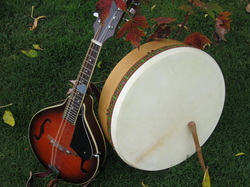 9. Participate in a Long Tradition: All music is part of a tradition, even the throw-away pop songs currently in fad, but folk music consciously taps into a long, venerable tradition. I can hardly imagine people in 200 years singing a Brittany Spears song, but I can imagine people still singing “Amazing Grace,” “Auld Lang Syne,” or “Greensleeves.” By learning and performing traditional folk music, you can participate in something that will outlive you and the particular fads of today. It’s not so much about individual ego as it is about understanding our place in the musical tradition, and for some (like myself) that can be a consoling thought. We are all mortal, but there is something in the best folk songs that endures.
1 Comment
8. Improve Your Songwriting:
You’d probably like your songs to be remembered for more than 15 minutes. But, how to do that? Well, if we only learn and perform other songs in the current trends, then those are the musical structures, themes, etc. that we will internalize. If you only listen to the flavour of the week, then that’s likely what you’ll write. Traditional folk music, on the other hand, has stood the test of time. So, we can enrich our own songwriting by studying those examples that prove a song can be relevant for hundreds of years. Don’t stop following current trends and the great music of today, but traditional folk music can help you ground your original songs in those deep themes and concepts that go to the root of our humanity. Modern music, after all, evolved from traditional folk music.  7. The Internet and Self-Production: It’s an exciting time to be a musician, as the Internet and home music production have greatly expanded our possibilities for reaching niche audiences. YouTube, Facebook, CDBaby and iTunes have made it possible for independent musicians to market directly to the listener, allowing us to bypass industry execs who only want to back the next big star who sounds like the last big star. Independent musicians no longer need labels to distribute our music to listeners from anywhere on earth. In other words, traditional folk music can be viable even if record labels don’t push it, even if your local town doesn’t have a venue for you to perform it. You can reach your audience partly or entirely online.  6. Reach a More-Diverse Audience: Traditional folk music can be great cross-over material: it can allow you to reach a larger and more-diverse audience than you might otherwise get. Folk music, because it is traditional, is uniquely able to engage different generations at once. It can gain the attention of people who might never seek out your original work. Once they hear you perform some folk songs they recognize, they may give your other work a shot. It’s the same reason that many new bands begin by covering previous hits. Traditional folk music allows you to do the same, but without having to pay for licensing a copyrighted song. If you want your music to reach beyond your own generation and region, then traditional folk music can help you achieve that. 5. Room for Innovation:
But, you might say, my audience isn’t chiefly composed of rustic farmers or old folks: how will my audience respond to folk music? The answer lies in how you adapt and deliver those traditional songs. The same traditional ballad can please grandparents at a town fair, young rockers at a punk show, or singer-songwriter fans in an urban café. Same song, different delivery. Dare to believe in the message of the songs, and deliver them the same way you’d deliver your original songs—take them seriously, and use modern vocal styling and instruments. The effect can be quite striking: a two-hundred-year-old ballad can take on new life. Many traditional folk songs have simple musical structures, so you can play them simply or adapt them to your musical tastes, turning them into anything from heavy metal to experimental jazz. If you’ve been turned off folk music by hearing corny, old-fashioned or sloppy renditions, then take on the challenge of giving the songs better treatment.  4. Recognisability: Not only might the songs be easier for you to learn because you’ve heard them before, but many of your listeners will likewise have heard the songs. It can really be tough to get audiences to engage with brand-new songs, as listeners in venues like bars/pubs tend to want songs they can sing along with, songs they already know. People are creatures of habit, but you can capitalize on that fact by incorporating some traditional songs into your set and/or album. You can lead your audience to see your new songs as part of a tradition that they already know and enjoy. |
Jesse's BlogThoughts on music and performing by Canadian singer-songwriter Jesse Ferguson. Categories
All
|
 RSS Feed
RSS Feed
